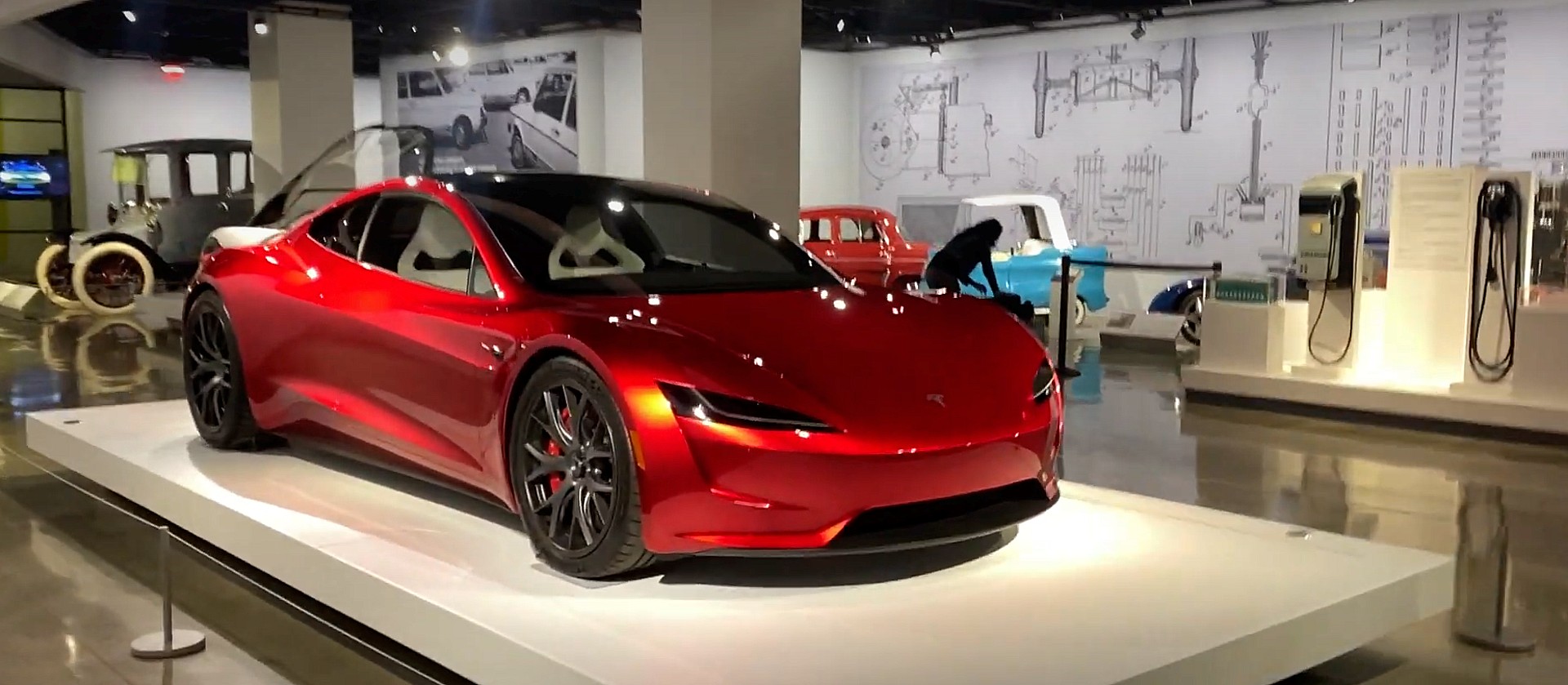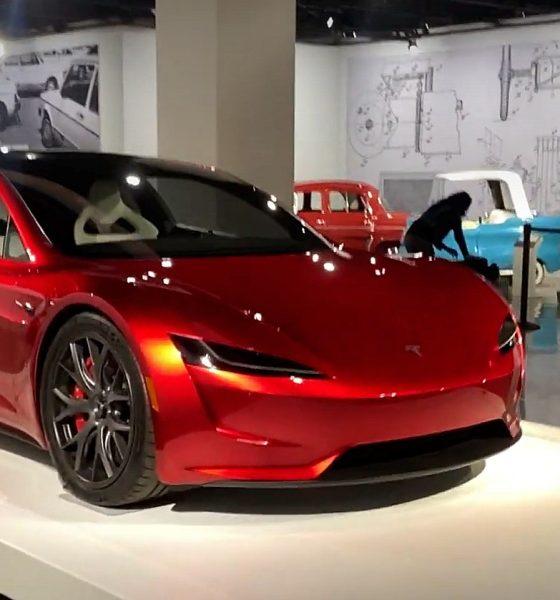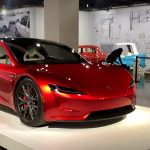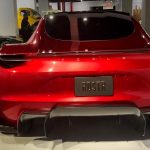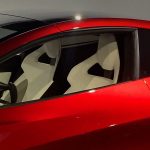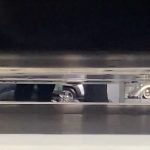Tesla’s next-generation Roadster is officially on display at the Petersen Automotive Museum in Los Angeles, and spectators are getting their first glimpses of the all-electric supercar.
Last week, it was announced that the Tesla Roadster would arrive at the Petersen Auto Museum for a two-week-long appearance in its own specialized exhibit. Tesla’s “halo car,” as it has been described in the past, is on display from today, May 19th, until June 2nd, 2021.
Now that the Roadster is officially in the Los Angeles museum, spectators are getting their first glimpses of the all-electric supercar ahead of its production push, which is scheduled to occur next year. Tesla unveiled the Roadster in 2017, but the company has focused primarily on increasing production of its mass-market vehicles, solving battery constraint bottlenecks, and working on producing its passenger cars before working on getting the Roadster in production.
Thanks to the YouTube account “gaussdog,” we are getting our first looks at the Roadster in the exhibit.
- Credit: YouTube | gaussdog
- Credit: YouTube | gaussdog
- Credit: YouTube | gaussdog
- Credit: YouTube | gaussdog
It appears that not much has changed with the Roadster since its last public appearance at Tesla’s Battery Day and Shareholder Meeting in September 2020. Since then, Tesla CEO Elon Musk has revealed some new details about the Roadster’s potential capabilities, including the ability to hover using a SpaceX package that would utilize cold gas thrusters to help it gain altitude. Additionally, these thrusters could be placed on the back of the vehicle to increase the Roadster’s already face-melting 0-60 MPH time of less than 1.99 seconds, similar to the Plaid+ Model S that was revealed in January.
Musk commented on the vehicle’s potential hovering ability during an interview with Joe Rogan:
“I want it to hover. I’m trying to figure out how to make this thing hover without, you know, killing people. I thought maybe we could make it hover, but not too high. So maybe it could hover, like, a meter above the ground, or something. So, if you plummet, you blow out the suspension, but you’re not going to die. Maybe, I don’t know, six feet. If we put a height limit on it, it will probably be fine.”
Musk added that the vehicle would be able to travel while in mid-air and that it would move “pretty fast.” However, he believes that certain restrictions should be put into place to decrease the risk of an accident. He mentioned a time restriction system that would automatically ground the vehicle after a certain period of time.
Acknowledging that the hovering may not be possible, Musk does believe that Tesla could still install thrusters behind the license plate to increase thrust.
Tesla Roadster could hit 0-60 mph in 1.1 sec with SpaceX thrusters
Musk plans to have a “release candidate design drivable by late Summer” and noted that finalizing the tri-motor drive system and advanced battery work were “important precursors” to solve before production begins.
Petersen has an “After Hours Experience” set up for the Roadster as well, and the cost is $45 per ticket and has limited availability. General admission tickets cost $16 for adults, $11 for children, and $14 for seniors.
Check out the first video of the Roadster from the Petersen Automotive Museum below, courtesy of gaussdog.
What do you think? Let us know in the comments below, or be sure to email me at joey@teslarati.com or on Twitter @KlenderJoey.

News
Tesla FSD fleet is nearing 7 billion total miles, including 2.5 billion city miles
As can be seen on Tesla’s official FSD webpage, vehicles equipped with the system have now navigated over 6.99 billion miles.

Tesla’s Full Self-Driving (Supervised) fleet is closing in on almost 7 billion total miles driven, as per data posted by the company on its official FSD webpage.
These figures hint at the massive scale of data fueling Tesla’s rapid FSD improvements, which have been quite notable as of late.
FSD mileage milestones
As can be seen on Tesla’s official FSD webpage, vehicles equipped with the system have now navigated over 6.99 billion miles. Tesla owner and avid FSD tester Whole Mars Catalog also shared a screenshot indicating that from the nearly 7 billion miles traveled by the FSD fleet, more than 2.5 billion miles were driven inside cities.
City miles are particularly valuable for complex urban scenarios like unprotected turns, pedestrian interactions, and traffic lights. This is also the difference-maker for FSD, as only complex solutions, such as Waymo’s self-driving taxis, operate similarly on inner-city streets. And even then, incidents such as the San Francisco blackouts have proven challenging for sensor-rich vehicles like Waymos.
Tesla’s data edge
Tesla has a number of advantages in the autonomous vehicle sector, one of which is the size of its fleet and the number of vehicles training FSD on real-world roads. Tesla’s nearly 7 billion FSD miles then allow the company to roll out updates that make its vehicles behave like they are being driven by experienced drivers, even if they are operating on their own.
So notable are Tesla’s improvements to FSD that NVIDIA Director of Robotics Jim Fan, after experiencing FSD v14, noted that the system is the first AI that passes what he described as a “Physical Turing Test.”
“Despite knowing exactly how robot learning works, I still find it magical watching the steering wheel turn by itself. First it feels surreal, next it becomes routine. Then, like the smartphone, taking it away actively hurts. This is how humanity gets rewired and glued to god-like technologies,” Fan wrote in a post on X.
News
Tesla starts showing how FSD will change lives in Europe
Local officials tested the system on narrow country roads and were impressed by FSD’s smooth, human-like driving, with some calling the service a game-changer for everyday life in areas that are far from urban centers.

Tesla has launched Europe’s first public shuttle service using Full Self-Driving (Supervised) in the rural Eifelkreis Bitburg-Prüm region of Germany, demonstrating how the technology can restore independence and mobility for people who struggle with limited transport options.
Local officials tested the system on narrow country roads and were impressed by FSD’s smooth, human-like driving, with some calling the service a game-changer for everyday life in areas that are far from urban centers.
Officials see real impact on rural residents
Arzfeld Mayor Johannes Kuhl and District Administrator Andreas Kruppert personally tested the Tesla shuttle service. This allowed them to see just how well FSD navigated winding lanes and rural roads confidently. Kruppert said, “Autonomous driving sounds like science fiction to many, but we simply see here that it works totally well in rural regions too.” Kuhl, for his part, also noted that FSD “feels like a very experienced driver.”
The pilot complements the area’s “Citizen Bus” program, which provides on-demand rides for elderly residents who can no longer drive themselves. Tesla Europe shared a video of a demonstration of the service, highlighting how FSD gives people their freedom back, even in places where public transport is not as prevalent.
What the Ministry for Economic Affairs and Transport says
Rhineland-Palatinate’s Minister Daniela Schmitt supported the project, praising the collaboration that made this “first of its kind in Europe” possible. As per the ministry, the rural rollout for the service shows FSD’s potential beyond major cities, and it delivers tangible benefits like grocery runs, doctor visits, and social connections for isolated residents.
“Reliable and flexible mobility is especially vital in rural areas. With the launch of a shuttle service using self-driving vehicles (FSD supervised) by Tesla in the Eifelkreis Bitburg-Prüm, an innovative pilot project is now getting underway that complements local community bus services. It is the first project of its kind in Europe.
“The result is a real gain for rural mobility: greater accessibility, more flexibility and tangible benefits for everyday life. A strong signal for innovation, cooperation and future-oriented mobility beyond urban centers,” the ministry wrote in a LinkedIn post.
News
Tesla China quietly posts Robotaxi-related job listing
Tesla China is currently seeking a Low Voltage Electrical Engineer to work on circuit board design for the company’s autonomous vehicles.

Tesla has posted a new job listing in Shanghai explicitly tied to its Robotaxi program, fueling speculation that the company is preparing to launch its dedicated autonomous ride-hailing service in China.
As noted in the listing, Tesla China is currently seeking a Low Voltage Electrical Engineer to work on circuit board design for the company’s autonomous vehicles.
Robotaxi-specific role
The listing, which was shared on social media platform X by industry watcher @tslaming, suggested that Tesla China is looking to fill the role urgently. The job listing itself specifically mentions that the person hired for the role will be working on the Low Voltage Hardware team, which would design the circuit boards that would serve as the nervous system of the Robotaxi.
Key tasks for the role, as indicated in the job listing, include collaboration with PCB layout, firmware, mechanical, program management, and validation teams, among other responsibilities. The role is based in Shanghai.
China Robotaxi launch
China represents a massive potential market for robotaxis, with its dense urban centers and supportive policies in select cities. Tesla has limited permission to roll out FSD in the country, though despite this, its vehicles have been hailed as among the best in the market when it comes to autonomous features. So far, at least, it appears that China supports Tesla’s FSD and Robotaxi rollout.
This was hinted at in November, when Tesla brought the Cybercab to the 8th China International Import Expo (CIIE) in Shanghai, marking the first time that the autonomous two-seater was brought to the Asia-Pacific region. The vehicle, despite not having a release date in China, received a significant amount of interest among the event’s attendees.
